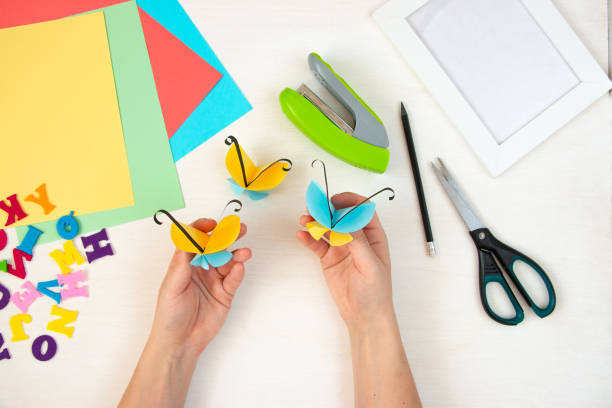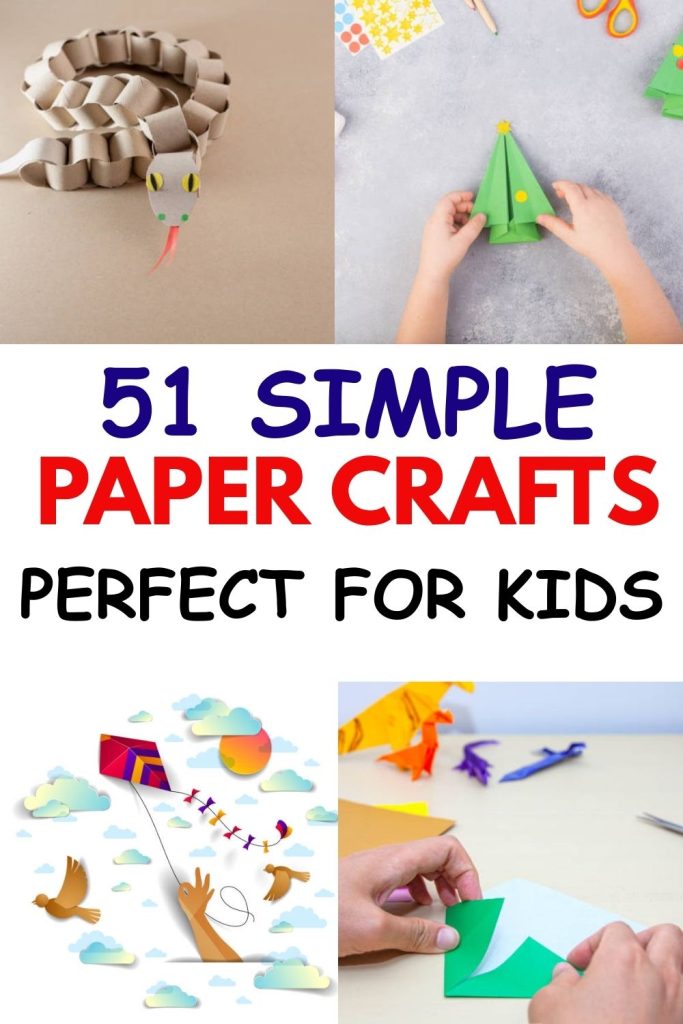Paper, Play, and Sticky Fingers
There’s something magical about the sound of scissors snipping through colored paper, or the squeak of a crayon dragging across a fresh sheet.
If you’re a parent, you’ve probably noticed that your child can get lost in those moments, tongue poking out in concentration, glue on their little fingers, and a masterpiece (or maybe just a gluey mess) taking shape before your eyes.
Sure, screens are everywhere now. But paper crafts? They’re timeless. They don’t need batteries, subscriptions, or even Wi-Fi. Just paper, a pair of scissors, and maybe a little glue. And you know what? Sometimes the simplest things really are the best.
This guide isn’t just about making Pinterest-worthy projects (though I’ll show you how to pull that off if you want). It’s about creating memories, keeping kids engaged, and giving parents a way to connect, without breaking the bank or setting up a craft station worthy of Martha Stewart.
The Magic of Paper and Scissors
Think about it: paper is humble, cheap, and always around. Yet in the hands of a child, it can become anything. A dragon. A rocket ship. A crown.
Crafting with paper is more than just entertainment; it’s developmental gold. Kids practice fine motor skills when they cut and fold. They learn patience when glue takes forever to dry (okay, sometimes you learn patience, too). And they gain confidence when a flat sheet transforms into something 3D and fun.
Do you remember making paper chains in school, counting down the days until summer vacation? Or fortune tellers with silly questions scribbled inside? Those small creations stick with us.
They were more than pape; they were social, playful, and sometimes, let’s be honest, a little mischievous.
That’s the same feeling we want to give our kids now.
Getting Set Up Without Stress
Here’s the thing: you don’t need a fancy craft room or bins of perfectly labelled supplies. Half the time, the magic happens on a kitchen table that’s also holding your coffee mug and last night’s mail.
But a little prep does make it smoother. Here’s a short list to keep on hand:
- Construction paper (the more colours, the better)
- Child-safe scissors (blunt tips, so you don’t panic every time they cut)
- Glue sticks and/or white glue (glue sticks are less messy, white glue sticks better)
- Crayons, markers, or colored pencils
- Tape (regular or washi tape for a fun flair)
- Stickers or googly eyes (not essential, but kids love them)
Optional bonus items: paper plates, paper bags, cupcake liners, and pipe cleaners. These things are like craft wildcards they open endless possibilities.
And here’s my little digression: as parents, we sometimes overthink the setup. We imagine the picture-perfect supply caddy from Pinterest, every marker in rainbow order. Reality? You’ll spend twenty minutes colour-coding, and your kid will immediately dump the whole box on the floor. So keep it simple. Throw supplies in a basket, call it “the craft bin,” and you’re good.
Crafts Kids Actually Enjoy (and Won’t Abandon Halfway)
Let’s be real: kids are unpredictable. They’ll beg for an activity, then five minutes later, they’re onto the next thing. So the best paper crafts are the ones that grab attention quickly and don’t require a parent-level engineering degree.
Here are some tried-and-true winners:
1. Paper Plate Animals
This is basically a guaranteed hit. Hand your kid a paper plate, some markers, and maybe googly eyes. Suddenly it’s a lion, a pig, or a rainbow-colored unicorn. Add ears from cut-out triangles, tape on some yarn for a mane, and boom, you’ve got a zoo.
2. Handprint Flowers
Trace your child’s hand on colored paper, cut it out, and glue the “hand” to a green paper stem. Repeat with multiple colours for a whole bouquet. Parents love these because they’re keepsakes. Someday, you’ll hold that little paper hand and wonder how it was ever that small.
3. Paper Bag Puppets
Grab a plain paper lunch bag, flip it upside down, and let your child draw a face on the flap. Add yarn for hair, paper clothes, or whatever strikes their fancy. Then, when the glue dries, the real fun begins: puppet shows at the kitchen table. (Spoiler: they’ll be loud, chaotic, and hilarious.)
4. Accordion Paper Butterflies
Fold the paper back and forth like a fan, pinch it in the middle, and secure it with a pipe cleaner. Spread out the wings and you’ve got a butterfly. Kids love watching something so simple turn into something pretty.
5. Origami Boats and Hats
This one takes a little more patience, but kids love the “ta-da” moment at the end. Paper boats can float (at least for a few minutes before sinking), and paper hats make snack time instantly fun.
The best part? None of these crafts requires advanced prep or expensive supplies. And if a craft flops, well, that’s part of the story too.
Pinterest-Worthy but Totally Doable
Pinterest can be both inspiring and intimidating. You scroll through perfectly lit photos of crafts that look like they were made by professional designers, and then you look at your kid’s glue-drenched paper blob. Here’s the secret: those “perfect” crafts? They probably took an adult two hours and a photo filter.
Want your crafts to look cute without losing your mind? A few tips:
- Stick to two or three colour combos. Brights or pastels, either works, just keep it simple.
- Snap photos on a solid background (like a white table or even a piece of poster board).
- Add a fun prop, like a sprinkle of confetti or a cute mug in the corner.
But honestly? The fridge gallery is where the real magic happens. Tape those wobbly butterflies and crooked hearts right next to the grocery list. That’s Pinterest-worthy in its own right.
Sneaky Learning Through Crafts
Parents, here’s your secret weapon: crafts double as stealth education. Your child thinks they’re just glueing and colouring, but really:
- Cutting shapes, practising geometry basics
- Folding paper = early lessons in symmetry
- Counting petals or parts = math in disguise
- Storytelling with puppets = language and imagination skills
- Sharing supplies = practising patience and social skills
Here’s a confession: sometimes I enjoy the crafts more than my kid. Folding origami feels like a mini puzzle, colouring can be surprisingly calming, and there’s satisfaction in seeing something come together. If you feel the same, you’re not alone.
Seasonal & Holiday Paper Crafts
This is where Pinterest really shine: seasonal projects that double as décor.
- Valentine’s Day: Paper heart garlands, pop-up cards with sweet notes
- Halloween: Paper lanterns with spooky faces, pumpkin cutouts for windows
- Christmas/Winter: Classic snowflakes, paper advent calendars, tree ornaments
- Spring: Bunny ears headbands, flower wreaths, paper kites
- Summer: Sun-shaped mobiles, patriotic pinwheels, picnic placemats
There’s something about marking the seasons with handmade crafts. Kids remember the rituals more than the results. A paper snowflake taped to the window in December can spark nostalgia for years to come.
When Crafts Go Wrong (Because They Will)
Let’s be honest, crafts don’t always go smoothly. Glue spills. Scissors cut the wrong line. Someone cries because their butterfly wing ripped.
Here’s the reminder: it’s okay. Crafting isn’t about perfection. It’s about trying, laughing, and sometimes making a total mess. I’ve had days where the “finished product” went straight into the recycling bin, and you know what? My kid still had fun.
If things start to unravel, shift the focus:
- Celebrate effort, not outcome (“I love how hard you worked on those folds”).
- Make up silly names for “mistakes” (a lopsided butterfly becomes a “flying potato bug”).
- Take a break and come back later.
Craft time is practice for real life; sometimes it works, sometimes it doesn’t.
Storing, Displaying, and Letting Go
The tricky part comes after the craft: what do you do with all of it?
- The rotating fridge gallery: Hang up a few crafts, then swap them out when new ones come along.
- Photo archives: Snap pictures before recycling. That way, you keep the memory without the clutter.
- Memory boxes: Save the truly special pieces, first scribbles, handprint flowers, cards made “just for you.”
Here’s a gentle truth: you can’t keep everything. And that’s okay. What matters isn’t the paper itself but the moment of making it.
Beyond Paper – Expanding the Craft Habit
Paper is the gateway, but kids will eventually want more. Paint, clay, beads, cardboard forts, the list goes on. But paper will always be the easiest, least messy fallback.
When you don’t have the energy to scrub paintbrushes or vacuum glitter, paper crafts swoop in like the hero parent’s been waiting for.
Conclusion: A Table Full of Paper, a Heart Full of Memories
At the end of the day (oops, better phrase that differently), what sticks with kids isn’t whether the folds were sharp or the glue was neat. It’s the time you sat down together. The silly voices during a puppet show. The laughter when the paper boat tipped over in the sink.
Crafts aren’t about Pinterest perfection; they’re about presence. They’re about showing kids that a little creativity, a little mess, and a lot of love can turn an ordinary afternoon into a memory that lingers.
So next time you’ve got some construction paper lying around, grab it. Sit down with your child. And just start snipping, folding, and glueing. Because these are the small, simple moments that somehow turn out to be the big ones.

